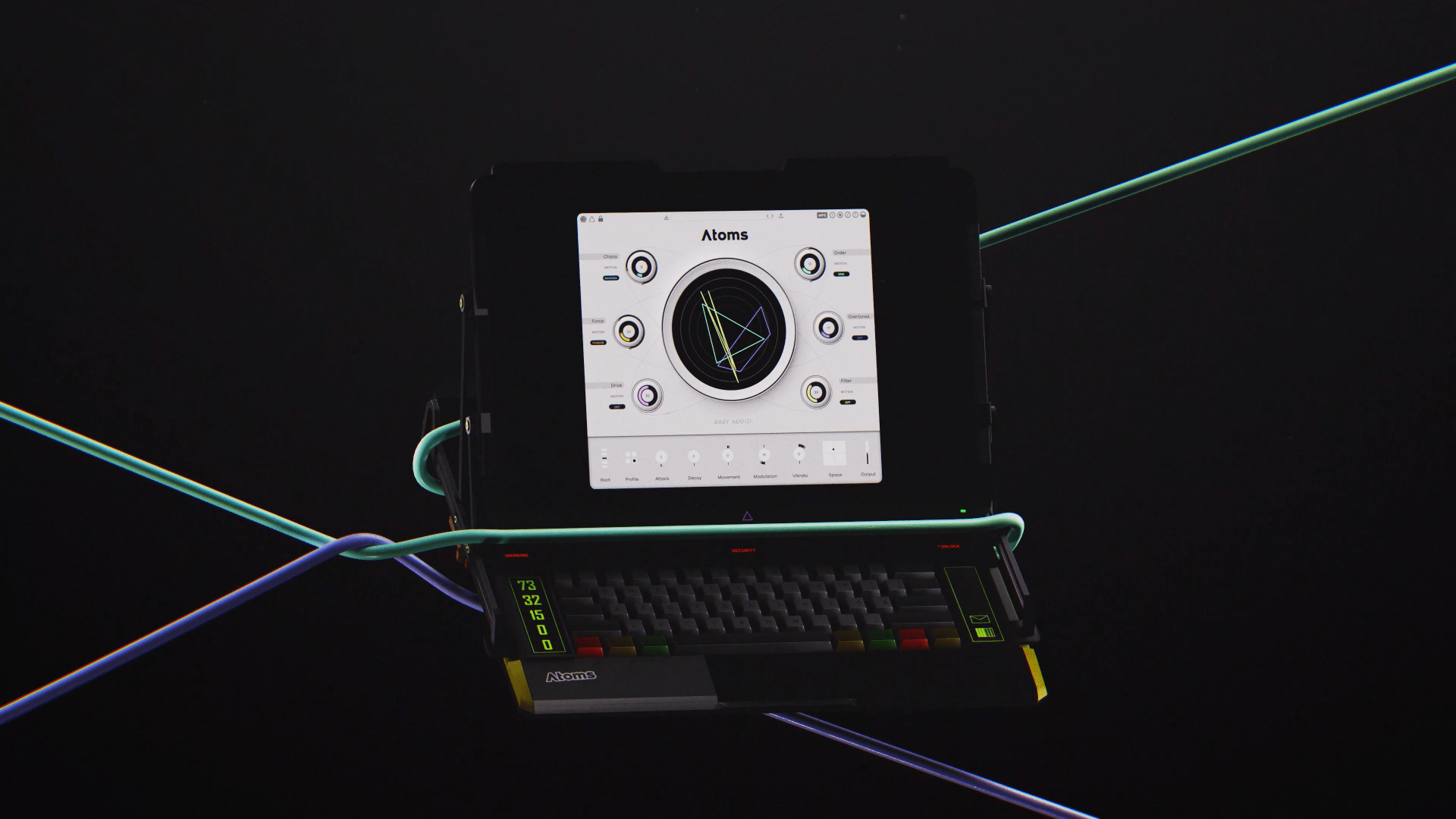What is Physical Modeling? 5 Techniques for Futuristic Sound

Physical modelling is one of the most fascinating approaches to sound synthesis.
It uses mathematical techniques to create sounds that mimic the behavior of real-life instruments.
But physical modelling is far from just a theoretical exercise. It’s a powerful synthesis tool that can change how you think about timbre in music.
In this article, I’ll explain what physical modeling is, how it works, and the five most common techniques you’ll find in physical modelling synthesis today.
What is physical modeling?
Physical modeling is the term for synthesis methods that simulate the behavior of sound producing objects in the real world.
Acoustic instruments rely on strings, membranes, air columns, or other physical structures to create their sound.
Physical modeling uses clever algorithms to recreate these mechanisms in the digital domain. The result is virtual instruments that generate sound in the same way as the traditional instrument families like strings or woodwinds.
But unlike conventional instruments, physical models aren’t bound by the limitations of real life.
What would a cello sound like if it were the size of a car? Or what if the air inside a flute were much less dense?
These are the types of intriguing sonic questions you can explore with physical modeling.
How does physical modeling work?
Sound producing bodies can be broken down into component parts that each play a role in turning energy into sound waves.
Think of a violin bow dragging along a string. The slipping and sticking of the bow creates friction as it passes along the string, adding energy to the system.
The energy causes the string to vibrate and the body of the violin amplifies that resonance. The player’s fingers change the length of the string as they move between notes, affecting the fundamental frequency of the vibration.
In the world of physical modelling, the scratchy bow can be represented by a burst of noise, while the size and resonance of the body can be approximated with filters and other techniques.
Today’s sound designers have a deep understanding of the physics of acoustics, leading to ever more accurate physical modelling algorithms.
Types of physical modeling used in synthesis
There are as many approaches to physical modeling as there are sound producing phenomena in the world.
Synth designers have developed different techniques to imitate all kinds of instruments, from struck bodies to masses of air and even networks of springs.
Here’s a guide to the common physical modelling methods found in instruments available today.
1. Karplus-Strong string synthesis
Karplus-Strong string synthesis was one of the first physical modelling algorithms to be identified and developed.
It uses a surprisingly simple system to simulate the behavior of a struck or or plucked string.
To start, a burst of noise gets fed into a feedback loop consisting of a delay line and a low-pass filter. This simulates the complex harmonic content produced when a string is plucked.
The delay line represents the length of the string, with the delay time determining the pitch of the note.
The low-pass filter, which slightly attenuates the high frequencies with each pass through the loop, simulates the energy loss that occurs in a real vibrating string due to factors like air resistance and friction.
As the sound repeatedly cycles through the delay line and filter, it begins to take on a characteristic that closely resembles that of a plucked string instrument.
The decay of the sound can be controlled by adjusting the feedback level and the filter's characteristics, allowing for the simulation of different types of string materials and plucking techniques.
2. Digital waveguide synthesis
Building on the work of Karplus and Strong, digital waveguide synthesis was developed in the 80s by Julius O. Smith III.
It goes even further to simulate the propagation of a sound wave within a medium.
By modelling the way sound waves travel back and forth along a string or within a tube with additional delay lines, this method can reproduce instruments like guitar or flute.
In digital waveguide systems, the delay lines update continually to model the reflection of waves at boundaries like the nut and bridge of a guitar or the ends of a flute.
This requires filters and other signal processing elements to simulate the frequency-dependent energy losses that occur in real-world physical mediums.
Designers craft these elements to reflect the acoustic properties of materials like the density and tension of a string or the characteristics of the air column within a wind instrument.
3. Mass-spring interaction networks
This unique method models a physical system as a network of masses connected by springs.
Each mass is a point of inertia with its own physical characteristics like weight and density. The connecting springs can move back and forth by contracting or expanding.
When the system is excited by a virtual bow or pluck, forces of tension and compression act on the network to push and pull the springs. This action produces complex vibrations and sound waves.
The physical laws of motion determine the interaction of points in the network and the sonic results they produce.
By adjusting the parameters of the masses, springs, and their connections, this approach can simulate wide ranging acoustic properties and behavior, including nonlinear and chaotic systems.
If that sounds complex, you can get a sense for how it works by experimenting with an instrument based on this technique.
Our Atoms synthesizer uses cutting edge research on mass-spring interactions to produce an instrument that’s easy to use, yet unlike you’ve ever heard.
Its six simple parameters act on the mass-spring network in ways that push, pull and mangle its structure as it vibrates.
The result is an eerily, organic texture that can evolve and shift as you play.
Watch how Atoms produces unique sound with mass-spring interaction networks in our tutorial video.
4. Modal synthesis
Modal synthesis is a physical modelling approach that takes inspiration from the resonant behavior of acoustic objects.
It's often used to simulate percussion instruments like drums, bells and mallet instruments.
It works on the principle that any sound can be decomposed into individual modes of vibration.
Each mode represents a specific way in which the object vibrates and resonates at a particular frequency.
The modes are typically represented by sets of filters tuned to each modes resonant frequency that are excited by an input source like an impulse.
This allows them to mimic the percussive strike of a stick or mallet on a resonant surface or membrane.
5. Formant synthesis
Formant synthesis focuses on replicating the vocal qualities of speech and singing with physical modelling methods.
It’s often implemented with a network of band-pass filters that correspond to formant frequencies that match those of natural speech or singing.
An input sound that mimics the role of the vocal folds like a buzz or hiss acts on the filter network to impart a distinctive vocal quality.
By changing the center frequencies and bandwidths of the formant filters over time, these systems can emulate different vowels, consonants and transitions.
How to use physical modelling to create unique sounds with Atoms
Atoms’ unique approach to physical modelling makes it exciting to explore if you’re on the hunt for new sounds.
After all, traditional subtractive synthesis and even FM have limits once you’ve used them a lot. But Atoms may be unlike anything else you’ve tried in the world of synthesis.
Here are four ideas to experiment with unique physical model at the heart of Atoms:
1. Use the Force and Overtones to add harmonics and control them with Order
Atoms is a mass-spring interaction network excited by the action of a virtual bow.
The Force control determines the pressure of the bow against the spring while the Overtones control determines its position along its length.
Just like a real bow, increasing the pressure on the spring will add a raspy, noise-like quality to the signal.
And bowing closer to the boundary will simulate playing closer to the bridge of a string instrument. This increases sharper high harmonics like those that occur when string players are indicated to play "sul ponticello."
Adding the Order control introduces high frequency damping to the springs. This acts in effect as a low-pass filter. Noisy excitation from the bow in combination with sharper overtones can yield interesting pizzicato-like effects when heavily damped with the Order control.
2. Control onset and decay with Attack and Release
If Atoms feels overwhelming at first, there are familiar elements you can fall back on as you experiment.
For example, Atoms’ attack and release controls work similarly to those in subtractive synths.
That said, these too are related to the action of the mass-spring the network rather than just a subtractive ADSR.
Attack refers to the velocity of the bow as it contacts the spring. Just like a traditional attack control, lower values produce a more abrupt onset, while higher ones create a gradual swelling effect.
Release controls the overall damping of masses in the system.
As physical forces like air drag and friction act on a vibrating spring, its energy will decrease over time causing the sound to decay.
Turning the release control up reduces damping for a longer decay.
3. Automate it all for evolving sound
The key Atoms expressive, organic sound is to get its parameter moving with the onboard automation controls.
Simply engage a Motion mode from the menu next to each of the six main parameters and set its range with the outer ring.
You can set the automation speed in Hz or sync to the session tempo to keep it all in time.
Experiment with the different Motion modes to see how each parameter interacts with the others as they move back and forth.
4. When in doubt, roll the dice
If you simply want to hear the range of different textures Atoms can produce, try hitting the randomize button represented by the Dice icon in the top left corner.
This engages a musically calibrated randomization function that produces new and usable sounds on demand.
But if you’d rather not randomize everything, you can exclude parameters from the randomizer by locking them with the lock icon.
Finally, if you just want a slightly different take on the patch you’re currently working with, you can hit the Recycle but to generate variations on the current settings.
The sound of science
Physical modelling is one of the last frontiers left in instrument design.
While it may seem complicated at first, there’s nothing scary about plugins and instruments based on this technology.
If you’re a creative producer curious about the future of synthesis, it’s worth exploring physical modelling to see how it can inspire you to create.
Try Atoms free to get started with physical modelling and mass-spring interaction synthesis.




.png)




